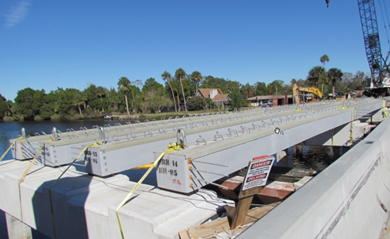Structures Design
Structures Design - Transportation Innovation Fiber-Reinforced Polymer Members and Structures |  |
Overview The deterioration of carbon-steel reinforced/prestressed (RC/PC) concrete and structural steel to is one of the prime causes for increasing maintenance costs and structurally deficient structures. In addition to being exposed to weather effects, transportation structures in Florida are also commonly located in aggressive environments such as chloride ion-rich coastal locations and inland water crossings with low pH (acidic) or high sulfate content (SO4). Structural steel is not permitted for use in the splash-zone as defined by the FDOT Structures Manual, and RC/PC structures with the splash-zone are typically required to utilize corrosion-resistant materials. Another innovative approach to combat this major issue is to utilize Fiber Reinforced Polymer (FRP) structures, members and/or components. FRP members are made from filaments or fibers bound in a polymeric resin matrix. FRP members of current interest are be made from various in-organic fibers such as glass (GFRP), basalt (BFRP) or carbon (CFRP). A surface coating is often provided for exposed elements to provide UV protection, or alternatively surface treatment (aggregate coating, deformations, or grooving) may be required at an interface to improve shear transfer to composite concrete surfaces. Beneficial characteristics of FRP reinforcing include:
Like any construction material, there are pros and cons to the use of FRP members:
Due diligence must be performed by the designer to ensure FRP benefits outweigh the costs of implementation for each component or system. Traditionally, composite materials like FRP have been used extensively in aerospace and consumer sporting goods applications where the material's high strength to weight ratios were first exploited. In the 1960s US Government agencies recognized the potential benefits that composites can provide to society's infrastructure and thus begin funding significant amounts of research in the field of FRPs. Since then advances in the field of polymers, advancements in production techniques and implementation of authoritative design guidelines have resulted in a rapid increase in usage of FRP materials, especially in the last 10 years. Because of these advances, the FDOT Structures Design Office has implemented specifications and design criteria to support the use of FRP materials in major bridge components. The use of these innovative material in certain Florida bridge components will keep Florida on the leading edge in the design of state-of-the-art transportation facilities. Usage Restrictions / Parameters Volume 4 of the Structures Manual (FRPG) provides guidance on where the members and structure can be used with and without prior approval from the SSDE:
These usage restrictions take into consideration the following items:
Design Criteria See the following references for the application of FRP members:
The potential use of FRP members for a given application will be evaluated on a project by project basis. Extensive coordination with the Structures Design Office may be required in order to develop acceptable final designs. See Structures Manual, Volume 4, Fiber Reinforced Polymer Guidelines for more information. Specifications Specifications 471 and 973 are available on the Specifications webpage for the use of FRP Fender Systems and similar components. Technical Special Provisions have been developed for several member types (such as Sheet Piles) which are available on request and will be converted to Developmental Specifications for broader application. Other specifications for structural components will be written and made available on an as-needed basis. Standards The following Standard Plans and associated Instructions are available on the Standards webpage for the standardized applications:
Future Developmental Standard Plans and associated Instructions will be published as needed on the Developmental Standard Plans webpage: Producer Quality Control Program FRP producers seeking to be included on the FRP Production Facility Listing may find guidance for material acceptance on the State Materials Office Fiber Reinforced Polymer Composites webpage. Listing is only available for products specifically addressed in the FDOT Standards and Specifications. Active or recently completed FDOT sponsored research projects:
The following links to FDOT meetings, seminars and workshops are provide as background information for potential users and industry partners:
AASHTO Innovation Initiative (A.I.I.) FHWA FRP Composite Technology Contact Information Steve Nolan, P.E. Senior Structures Design Engineer Phone: (850) 414-4272 e-mail: Steven.Nolan@dot.state.fl.us | |
